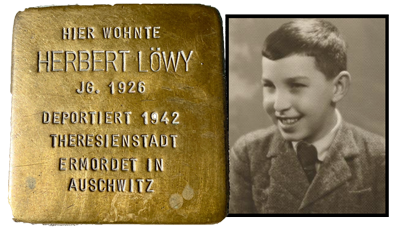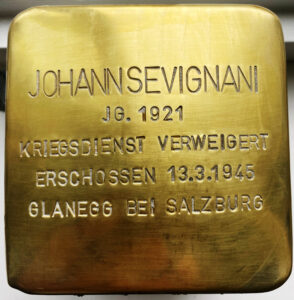Johann SEVIGNANI, born on December 5, 1921 in Ellmau near St. Johann in Tyrol and baptized Catholic, was the eldest of five children of the couple Rosa, née Walcher, and Johann Sevignani, who was a bricklayer and farmer by profession.
The family lived in Going am Wilden Kaiser. In 1932 the mother of the five young children died. Their older son Johann was an agricultural worker, milker and more. However, he was never politically active.
It is also documented that Johann SEVIGNANI had to serve in the German Wehrmacht in the war years 1941 to 1944 – three and a half years of his young life – last as a lance corporal in the Grenadier Regiment 673, which was »blown up and worn down« on the southeastern front in August 1944.
In a dossier of the intelligence service of the German Wehrmacht, dated October 24, 1944, one can read about the Grenadier Regiment 673 and Johann SEVIGNANI:
According to information from the Abwehr officer Hptm. Bliem, Gren. Rgt. [Grenadier Regiment] 673 was located on the Pruth River and was completely broken up and routed on the occasion of Romania’s surrender.
Smaller troops and loners fought their way through.
Sevignani probably fought his way through individually and was either on his way to Sommerein [near Bruck an der Leitha] or, more likely, to his home town.
The »Abwehroffizier [Defense Officer]« knew that the German Wehrmacht had lost its battle against the Soviet Army on the southeastern front and that the Wehrmacht soldiers scattered in the Hungarian-Romanian border area had taken flight to avoid falling into Soviet captivity.
Johann SEVIGNANI, one of the scattered Wehrmacht soldiers with cancelled field post numbers, tried single-handedly to make his way to Going am Wilden Kaiser.
When he left Brașov (German Kronstadt) on September 25, 1944, to escape imminent capture, he could not have known that the war was still going on for eight months and that in the hinterland so-called courts martial were passing death sentences for »desertion«.
This was to be SEVIGNANI’s undoing.
SEVIGNANI arrived in Austria on October 22, 1944. In Bromberg, near Wiener Neustadt, he was stopped by a gendarme coming out of an inn, who was preparing to establish the identity of the individual soldier on the basis of his soldier’s book.
A tense situation, a scuffle: a shot was fired from SEVIGNANI’s rifle, fatally wounding the gendarme.
A fatal event that made SEVIGNANI panic and leave behind his soldier’s book with proof of identity. He fled over the Semmering in the direction of his homeland, but was arrested by a search patrol in Radstadt on November 11, 1944 and handed over to the martial justice system.
Johann SEVIGNANI, 23 years young, three and a half years in the war effort, was neither a hero nor a conscientious objector of the first hour. He wanted to survive the war, which he failed to do.
He found himself in the detention center of the Salzburg Regional Court and was brought before a court-martial of Division 418.
»Oberstabsrichter [Chief of Staff]« Dr. Peyrer-Heimstätt1 acted as prosecutor, »Oberstabsrichter« Dr. Voggenberger2 as judge. Both were Austrian jurists, blood judges under the National Socialist regime in Salzburg.
On January 25, 1945, thus in the final phase of the war of extermination, the court-martial of Division 418 in Salzburg imposed the death penalty »in the name of the German people« against Johann SEVIGNANI for »desertion and murder«.
SEVIGNANI was sentenced for »desertion« – flight from the regimental flag. However, his regiment, »completely broken up and worn out«, no longer existed since August 1944.
Furthermore, SEVIGNANI was convicted of »murder«. For this, the Salzburg court martial did not use the Austrian penal code, but the murder paragraph 211 (para. 2 StGB), invented in the war year 1941 by National Socialist jurists, among them Roland Freisler:
A murderer is a person who kills a human being out of lust for murder, for the satisfaction of sexual urges, out of greed or otherwise for base motives, insidiously or cruelly or by means dangerous to the public or in order to enable or conceal another criminal act.
Accordingly, the court-martial was of the opinion that the previously blameless Johann SEVIGNANI had intentionally killed the gendarme Josef Bachmayer in Bromberg on October 22, 1944, »out of murderous desire«.
SEVIGNANI’s legal representative Dr. Gustav Aigner expressed his reservations about the death penalty for premeditated murder:
Now he [Sevignani] was actually stopped in Burgenland by the gendarmerie master Bachmayer and his papers were taken from him.
Sevignani, however, fled, was ordered by the gendarme to stop, actually wanted to surrender, pulled down the rifle to throw it from him and at the same moment a shot was fired which, without Sevignani noticing it, hit the gendarme.
It is understandable that Sevignani, shocked by this, flees again, only to be apprehended after some time.
The court-martial insisted on its verdict: murder under § 211 (1941). This was arbitrary justice.
In addition, the local group leader of the NSDAP and mayor of Going am Wilden Kaiser had given his young community citizen Johann SEVIGNANI a bad character reference.
SEVIGNANI’s »plea for mercy«, written by his legal representative, was rejected by Heinrich Himmler as commander-in-chief of the reserve army:
I confirm the verdict. I refuse to grant clemency. The sentence is to be carried out. Field Command, 23 Feb. 1945
The Reichsführer SS and Commander-in-Chief of the Reserve Army: gez. H. Himmler
On March 12, 1945, Lieutenant General Otto Schönherr3 as head of the court ordered »the immediate execution of the sentence«:
For this purpose I order:
1.) To provide an officer and 10 men as an enforcement detachment.
2.) to provide a detachment in minimum platoon strength of badly judged or judicially convicted soldiers of all companies of the battalion, who must be present at the execution for educational and deterrent reasons.
3) To appoint 2 men to pick up the convict and transfer him from the prison to the place of execution. Extreme danger of escape.
4) The court of Division No. 418 Salzburg is to be informed of the events under 1) to 3) by 10 a.m. on March 13, 1945.
Johann SEVIGNANI was 23 years young when he was shot at 4:37 p.m. on March 13, 1945, at the military firing range in Glanegg near Salzburg by a ten-man »execution squad« – »Kommando Feuer [Command fire]«, succinctly recorded by »Oberstabsrichter« Dr. Voggenberger, blood judge and head of the execution.
Karl Völk, pastor of the Wehrmacht base in Salzburg, had accompanied Johann SEVIGNANI pastorally from his cell to the place of execution:
He [John SEVIGNANI] received the holy sacraments with filial devotion. I stayed with him until his death. He sent the rosary and the prayer book to his father.
Shortly before his death he said: The father may place a bouquet of flowers on his mother’s grave as a sign of grateful love for her.
According to current knowledge, Johann SEVIGNANI was the fifteenth and last victim of wartime justice who was shot on the military firing range in Glanegg near Salzburg and buried anonymously in the municipal cemetery – a murder machinery that functioned without interference.
It is nevertheless strange that SEVIGNANI appears neither in the documentation Resistance and Persecution in Salzburg 1934-1945, published in 1991, nor in the digital database of victims of the Documentation Center of the Austrian Resistance.
Finally, it should be noted that Johann SEVIGNANI’s younger brother Josef, born on August 13, 1925 in Going, was shot near Trieste on April 30, 1945.
Three siblings and their widowed father survived the terror years.
1 Dr. Erich Peyrer-Heimstätt (b. 1899, d. 1977 in Salzburg), in his civilian profession notary, in the war years 1944/45 »chief judge« of the court martial of division 418, in liberated Austria again in his civilian profession, finally member of the board of trustees of the International Mozarteum Foundation and president of the Friends of the Salzburg Festival.
2 Dr. Ferdinand Voggenberger (b. 1894, d. 1967 in Salzburg), judge at the Salzburg Regional Court, »Kriegsgerichtsrat« and »Oberstabsrichter«, dismissed in 1945 for NSDAP membership, considered »inferior incriminated«, amnestied, then lawyer in Salzburg.
3 Lieutenant General Otto Schönherr (Edler von Schönleiten, born 1888 in St. Pölten, died 1954 in Ried, Tyrol), was an officer in the Imperial and Royal Army. Army, the Austrian Federal Army, and the German Wehrmacht, commander of Division 418 stationed in Salzburg until liberation by the Allies; he was father of the actor Dietmar Schönherr, who was active in the German peace movement and in solidarity projects in Nicaragua.
Sources
- Austrian State Archives: court martial file St. L. II 9/1945
- Archives of the Archdiocese of Salzburg: military matrices, death register (communication dated 19. 1. 2022)
- City Archive Salzburg: Communication from the cemetery administration
Translation: DeepL
Stumbling Stone
Laid 27.09.2022 at Salzburg, Kajetanerplatz 2




